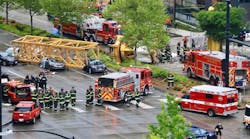Seattle, Dallas Crane Accidents: How to Avoid Construction Liabilities
Haunting dashboard camera footage shows what happened. On April 27, 2019, a construction crane—in the process of being dissembled—fell from the top of a building in Seattle, killing four people and crushing six vehicles on the street below.
Now, five companies are being investigated in connection with the collapse by the Washington State Department of Labor and Industries, according to the Seattle Times.
(April 27, 2019: crane collapsed in Seattle, killing four people. Credit: Shutterstock)
On June 9, 2019, a crane collapsed onto an apartment building in Dallas, TX, killing one person and injuring at least five others. The crane was erected at a nearby building under construction, according to the New York Times.
Construction projects inherently come with risks and potential hazards—but to avoid liabilities, it’s important to realize what you, as a facilities manager or building owner, are and aren’t responsible for.
Michael Welbel, vice president of national insurance brokerage Risk Strategies, says construction hazards can be exacerbated when a crane is involved.
[Related: How to Avoid Progressive Collapse in Your Building]
“If you’re in a place like New York, you see cranes all the time in congested areas,” he says. “You can just imagine the amount of damage that could happen in the event of a failure with all of those hoisting and lifting activities. Failure of the equipment could cause very serious harm to people and the property.”
How to Avoid Construction Liabilities
Welbel says in scenarios like the one in Seattle, a building owner is potentially liable, because they could be responsible for all invitees on the property. In New York, the Safe Place to Work Act holds building owners, contractors and employers liable if they don’t comply with safety laws.
(April 27, 2019: crane collapsed in Seattle, killing four people. Credit: Shutterstock)
Often, the construction workers are contracted out, Welbel says. “I’m a facilities manager replacing a unit or piece of equipment on my roof structure that we manage or own,” he explains. “What do we do? We’re going to hire a contractor, which oftentimes will have a subcontractor, which in turn will have another subcontractor. How do I know, as a facilities manager or building owner, that these people are responsible and have a good track record?”
[On topic: Track roof damage with aerial photography]
1. Ensure your contractors have adequate insurance.
“Facilities managers in particular are very good about this, in terms of specifying required insurance,” Welbel says. Look for general liability, workers’ compensation and even auto liability. “Usually, equipment is drivable.”
Then, follow up on those insurance certificates, because insurance policies have natural termination dates. Make sure they’re up to date, and that the coverage remains in place until the project is done and for a period of time afterward.
2. Have indemnification provisions in your contracts.
These are used in contracts to shift potential costs from one party to the other. “It will say if the facilities manager or building owner does in fact get sued, [the contractor] is going to take care of them. They’re going to pay for their legal payments on their behalf. … But that doesn’t apply to a building owner’s own negligence.”
3. Be cautious when speaking about safety concerns.
You could inadvertently take on liability, Welbel says. “People naturally want to be helpful and don’t want people to get hurt,” he explains. “They might see something isn’t properly tied down or they’re expecting heavy winds. So they’ll go to the operator and tell them to fix it. Now, they’re taking on that obligation because they’re directing the work. You don’t want to do that—but you also don’t want to turn your back on unsafe conditions.”
[Related: 10 Common Mistakes in Your Emergency Action Plan]
Welbel says to communicate those concerns to the people that are responsible. “That conversation might be, ‘I’m not assuming any obligation, but I see something that you may want to look at.’ That way they’re not saying they’re responsible, but they’re aware of a potential problem and are trying to avoid it,” Welbel says. “You have to be cautious. A lot of people are helpful by nature and can assume liability that they otherwise would not have.”
Safety First
Construction projects undoubtedly come with risks. To avoid potential harm to people and your property—and even legal action—it’s important you properly vet the people you hire, and that they come with reliability and a successful track record. But make sure your contracts have what they need for protection in the event of a failure.
Two handpicked articles to read next:



